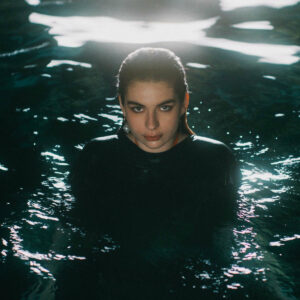
There are voices that pierce. There are voices that echo. And then there are voices that haunt quietly — softly lodged in the in-between of your thoughts, like a foggy memory or a passing dream. Adèle Castillon possesses the third kind.
In an age of maximalist pop and algorithm-driven virality, Castillon’s sound is tender, minimalist, and hypnotic. She doesn’t demand your attention — she invites it. And once you enter her world, there’s no easy exit.
A Performer Before a Pop Star
Born in 2001 in Angers, France, Adèle Castillon is not your average pop ingénue. Before ever stepping into a studio, she was already making waves as a YouTuber and an actress. Her early work in French cinema — particularly her role in the psychological thriller L’Heure de la Sortie (School’s Out) — revealed a deep sensitivity and interiority that would later seep into her music. She wasn’t just performing; she was communicating in codes, eye flickers, and silences.
In 2018, Adèle co-founded Videoclub, an indie pop duo with her then-partner Matthieu Reynaud. Their breakout track, “Amour Plastique”, blew up almost instantly — a viral hit drenched in pastel visuals, dreamy synths, and a nostalgic aura reminiscent of Stranger Things. The lyrics, sung in French, conjured imagery of delicate love, loss, and longing. Their music didn’t scream Gen Z — it whispered it. When Videoclub disbanded in 2021, it wasn’t an end — it was Adèle’s rebirth as a solo artist.
The Sound of Digital Melancholy
To call Adèle Castillon’s music “just pop” would be to undersell it entirely. It’s part chanson, part ambient R\&B and part lo-fi experimental diary entry. She floats between genres, borrowing from 80s synthwave, classic French chanson, alt-R\&B, and bedroom pop — never quite settling, never quite conforming. Her solo material—particularly tracks like “Impala,” “Ton Regard,” and “Rêve”—showcases a sonic palette that is both vintage and futuristic, with her reverb-soaked vocals and drum loops that mimic the hazy tempo of a heart skipping or breaking. Her influences are clear yet elusive: there’s a touch of Françoise Hardy’s softness, Billie Eilish’s modern melancholy, and The XX’s stark emotional honesty. But there’s also something distinctly Adèle in how she leaves space — between notes, between beats, between words. That space is her secret weapon.
The Rise of Retro-Futuristic R\&B
To understand Adèle Castillon’s place in the modern music landscape, it helps to situate her within the rising tide of Retro-Futuristic R\&B — a genre that, while hard to define, is increasingly shaping European music. It’s a sound rooted in the past but dressed in futuristic fabric: warm analog textures, nostalgic melodies, and minimal, synth-laced beats. Where traditional R\&B leans on vocal acrobatics and soul-driven delivery, this new wave thrives on mood — atmospheric, introspective, and intimate. She doesn’t emote — she suggests, and we follow. While artists like Jorja Smith, RIMON and Ama Lou are forging this genre in English-speaking territories, Adèle is shaping it in French, a language that adds layers of romance and restraint to the already tender soundscape.
Aesthetic as Philosophy
In the era of short-form content and visual overstimulation, Adèle Castillon operates like an auteur. Her visuals — from music videos to social media presence — carry a consistent aesthetic of retro elegance and modern melancholy. Muted colors. VHS tape grain. Oversized sweaters. Rain on windows. Long stares. Neon lights in slow motion. There’s a studied nonchalance to it all—like she’s always walking through a Wes Anderson dream left out in the cold. This isn’t accidental. Adèle’s generation lives online, but it longs for the tactile — film cameras, cassette players, handwritten notes. Her world-building taps into that longing. She’s not just making songs; she’s curating moments.
A Language of Her Own
Choosing to sing in French is a deliberate artistic move by Castillon. In a music industry where English often dominates global charts, she remains committed to her native language. The result is a deeper, more authentic connection with her audience—many of whom engage emotionally, even if they don’t understand every lyric. Her writing leans toward the poetic and introspective, favoring mood and sensation over straightforward storytelling. Lines like: “Ton regard, un écho dans ma tête” (Your gaze, an echo in my head) or “Je me perds dans le bruit de ta voix” (I lose myself in the noise of your voice) — are not just phrases. They’re feelings wrapped in texture—delicate, haunting, and impossible to ignore.

Global Appeal, Local Roots
Despite her deeply French identity, Adèle Castillon’s music is spreading globally. TikTok edits, YouTube fan videos, and Spotify algorithm placements are carrying her voice across borders — to listeners in Mexico, Germany, Brazil, Italy, and beyond.
Why? Because her music captures something universal: The ache of young love, The loneliness of being seen but not known, The beauty of small moments, The desire to belong without being consumed. She belongs to a global class of artists reimagining intimacy in the digital age.
What Lies Ahead
There’s quiet buzz around a full-length solo album — rumored to be steeped even deeper in alt-R\&B, electronica, and cinematic storytelling. With whispers of collaborations across borders — possibly with producers from London, Berlin, and even Monte-Carlo — Adèle might be shaping up to become one of Europe’s most emotionally intelligent exports. And perhaps that’s her legacy in the making: a translator of emotions in a language that transcends translation. In an industry dominated by noise and spectacle, Adèle Castillon whispers — and we listen. She stands at the intersection of vintage and future, intimacy and anonymity, softness and strength. In doing so, she doesn’t just reflect her generation — she shapes it. Through lo-fi textures, soulful synths, and a gaze that always seems to look inward, Adèle is not merely making music — she’s setting the mood, giving it meaning and she’s making it memorable. And in a world too loud to hear itself think, that’s exactly what we need.
Want more emerging music stories? Subscribe, leave a comment, or share this post with someone who craves a little lo-fi magic today.
